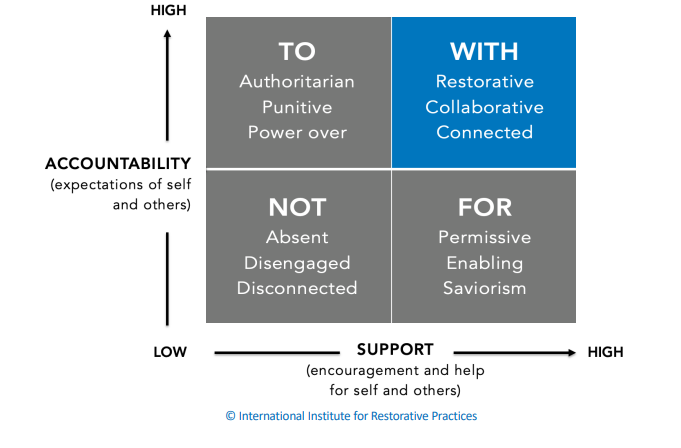- Columbus City Schools
- Restorative Practices
Restorative Practices Principles
-
Engagement Window
 The fundamental hypothesis of Restorative Practices refers to the Engagement Window, which is considered the “Cornerstone” of Restorative Practices.
The fundamental hypothesis of Restorative Practices refers to the Engagement Window, which is considered the “Cornerstone” of Restorative Practices. 
The Engagement Window is a framework and reminder for developing relationships and community through interactions that balance high STRUCTURE (limit setting, discipline) with high SUPPORT (encouragement, nurture). Each block represents a type of relationship and provides information about how we view and work with others in terms of boundaries, limits, expectations, the amount of support provided, relational power and connection.
- The aim is for educators in authority to interact WITH people and not TO them or FOR them.
- School staff can also use the Engagement Window to reflect and ask “Was that interaction restorative? What could I do to be more WITH and more restorative in my next interactions?”
-
Affects, Feelings and Emotions
 Affect is the underlying experience of feeling, emotion, attachment, or mood. It encompasses many emotional states and can be positive (e.g., happiness, joy, excitement) or negative (e.g., sadness, anger, fear, disgust). It is a fundamental aspect of human experience. Restorative practices encourage us to be aware of ourselves and use tools and strategies that can impact school and work environments.
Affect is the underlying experience of feeling, emotion, attachment, or mood. It encompasses many emotional states and can be positive (e.g., happiness, joy, excitement) or negative (e.g., sadness, anger, fear, disgust). It is a fundamental aspect of human experience. Restorative practices encourage us to be aware of ourselves and use tools and strategies that can impact school and work environments. -
Fair Process
 Fair Process is a key factor in building the trust needed to develop a safe, strong, supportive school community.
Fair Process is a key factor in building the trust needed to develop a safe, strong, supportive school community. Fair process is important for developing trust that is necessary for strong relationships and strong community. “Individuals are most likely to trust and cooperate freely with systems – whether they themselves win or lose by those systems – when fair process is observed.” (IIRP).
-
Restorative Continuum

The restorative continuum is a range of impactful strategies used to build community, nurture relationships and address conflict when it occurs. It spans from preventative approaches to responsive restorative actions, aiming to prevent harm, repair relationships, and foster growth in communities, workspaces, and classrooms.
Being 80% proactive in this continuum is important because it focuses on prevention, reducing the need for reactive interventions. Proactive measures that promote empathy, emotional regulation, and communication skills such as active listening, help create a positive and healthy environment, minimizing conflicts. This approach efficiently uses strategies, promotes a supportive culture, and ensures that when harm does occur, 20% responsive actions are used to repair and foster growth, leading to a more respectful and understanding community.

